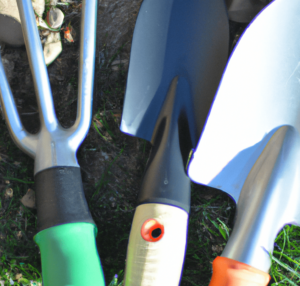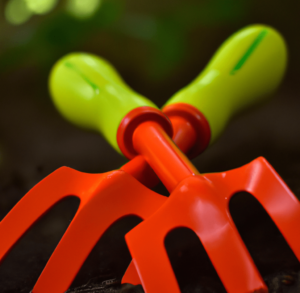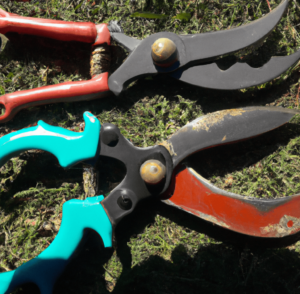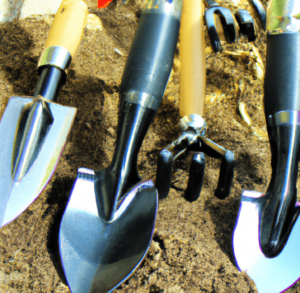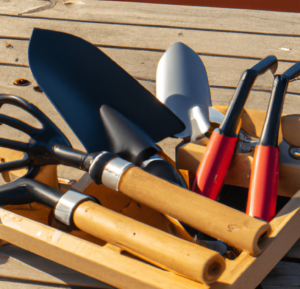Gardening tools are essential for any gardener, and they must be properly maintained and cared for to last for many seasons. Failure to clean and maintain your gardening tools can cause rust, which can weaken and damage the tool, making the most essential tools for every gardener ineffective and even dangerous to use. In this article, we’ll discuss how to properly maintain and care for your garden tools!
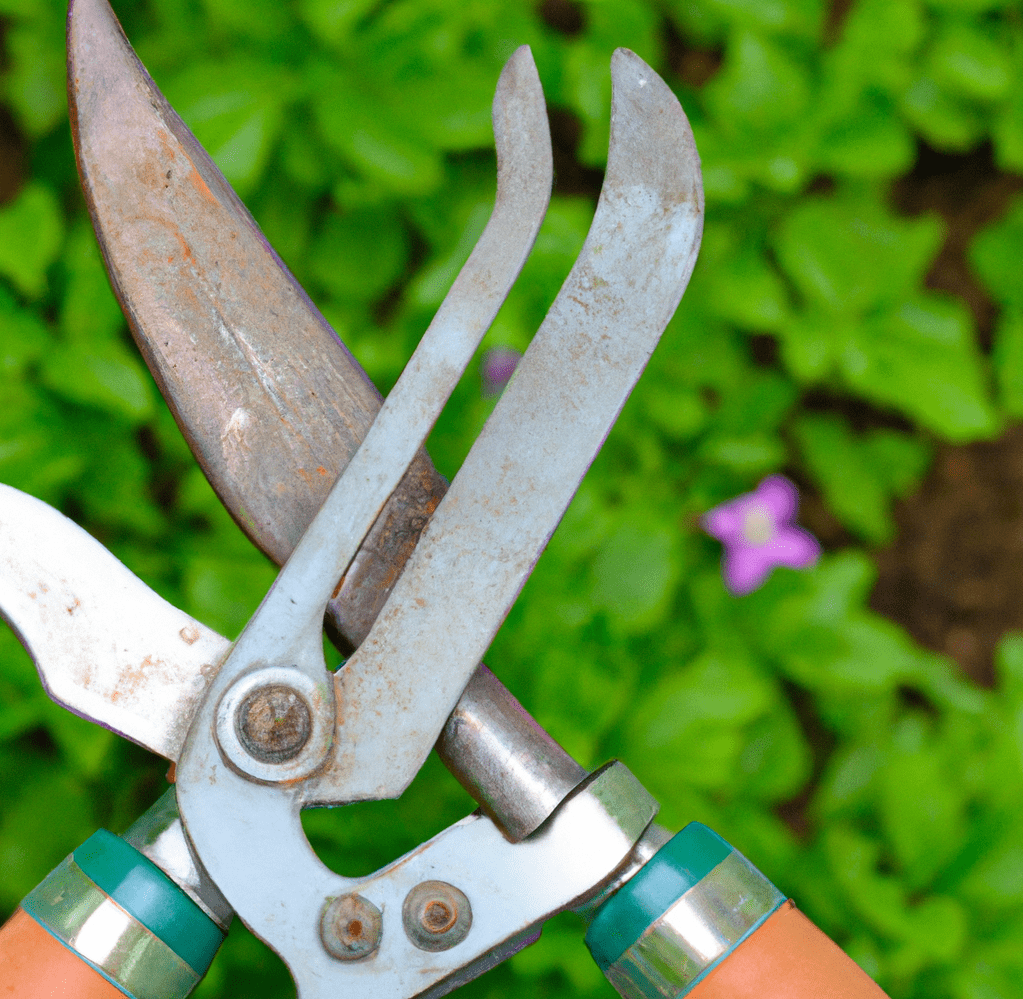
Cleaning and Disinfecting
Cleaning and disinfecting your tools is an important part of learning how to properly maintain and care for your garden tools. Gardeners should clean their tools after each use to remove dirt, debris, and any accumulated bacteria or fungus.
Importance of Regularly Cleaning and Disinfecting Garden Tools
Gardening tools are essential for any gardener, and they must be cleaned and disinfected on a regular basis for several reasons. To begin, you have to learn about how to properly maintain and care for your garden tools because it helps to remove dirt and debris that can accumulate after each use, ensuring that the tools are in good working order and ready for the next gardening session.
Dirt and debris can also attract moisture, which can lead to rust and corrosion, weakening and decreasing the effectiveness of the tools. Gardeners who work with plants that are susceptible to disease or pests may also choose to disinfect their tools after each use to prevent the spread of these issues from one plant to the next. This is especially important for pruning shears, which come into direct contact with plant tissues.
Wet conditions can also provide an ideal environment for bacteria and fungus to grow, so it’s critical to thoroughly dry your tools after cleaning and disinfecting them. Gardeners can ensure that their gardening tools are in good working order and ready for their next gardening session by cleaning and disinfecting them on a regular basis.
Steps for Cleaning and Disinfecting Different Types of Tools (e.g. Hand Tools, Power Tools)
Now that you know how to properly maintain and care for your garden tools, here’s how to clean and disinfect different ones:
- Remove any rust, caked-on dirt, or grease with a wire brush.
- To remove rust, soak the tool in a solution of equal parts white vinegar and water for several hours.
- To remove stubborn rust stains, make a paste of baking soda and water, apply it to the affected area, and let it sit for several hours before wiping it away with a damp cloth.
- If the rust is particularly stubborn, use a rust remover product made specifically for removing rust from gardening tools.
- After removing the rust, thoroughly dry the tool and store it in a dry, protected location to prevent future rust and corrosion.
Gardeners can effectively remove tough stains and rust from their gardening tools by following these tips, extending their life and keeping them in top working condition.
Tips for Removing Tough Stains and Rust From Tools
Learning how to properly maintain and care for your garden tools? Here are some pointers for keeping the proper edge angle on garden tools:
- Sharpen the blades at the proper angle with a tool sharpener or honing guide.
- When sharpening by hand, ensure that the blades are sharpened at the same angle each time. A consistent angle aids in the maintenance of the proper edge on the blades.
- Use a metal brush to remove any debris or rust that has accumulated on the blades after sharpening.
- When not in use, keep tools in a dry, protected place to avoid rust and other forms of corrosion.
Sharpening and Adjusting
Another important aspect of proper maintenance and care is sharpening and adjusting garden tools. Gardening tools can become dull or damaged over time, decreasing their effectiveness and making gardening tasks more difficult. Sharpening and adjusting your tools on a regular basis will keep them in good working order. This may entail sharpening blades with a tool sharpener or adjusting the tool to ensure proper operation.
Part of learning how to properly maintain and care for your garden tools is inspecting them on a regular basis for signs of wear or damage, and repairing or replacing tools that are no longer functional. Gardeners can ensure that their tools are always in good working order and ready for their next gardening session by sharpening and adjusting them. Furthermore, sharpening and adjusting tools on a regular basis can help to extend their life and reduce the need for frequent replacements, which not only saves money but also helps to reduce waste.
Steps for Sharpening and Adjusting Different Types of Tools (e.g. Pruners, Mower Blades)
Sharpening and adjusting various types of garden tools necessitates a different set of steps and techniques, depending on the tool and the level of maintenance required. As you learn how to properly maintain and care for your garden tools, keep the following in mind:
- Pruners: To sharpen pruner blades, use a sharpening stone or tool sharpener. Sharpen both blades evenly to ensure that the pruners cut cleanly and accurately.
- Sharpening mower blades: To sharpen mower blades, use a metal file or grinder. To maintain balance, sharpen both sides of the blade evenly. Use a metal brush to remove any debris or rust that has accumulated on the blade after sharpening.
- Sharpening shovels and hoes: Sharpen the edges of the blades with a metal file or grinder. To maintain balance, sharpen both sides of the blades evenly. Use a metal brush to remove any debris or rust that has accumulated on the blades after sharpening.
Gardeners can effectively sharpen and adjust their gardening tools by following these steps, which will help to keep them in top working condition and ready to use when needed.
Regular maintenance, such as sharpening and adjusting, is essential for preventing rust and other forms of corrosion, as well as keeping your tools in good working order.
Tips for Maintaining the Proper Edge Angle on Cutting Tools
If you’re learning how to properly maintain and care for your garden tools, here’s how to maintain the sharp edge on some of them:
- Garden tools must be properly stored and transported to ensure their longevity. To avoid rust and corrosion, keep tools in a dry and cool place.
- When transporting tools, use a sturdy container, such as a bucket, to protect them from damage.
- Cleaning and disinfecting your tools on a regular basis, lubricating moving parts, and protecting metal surfaces all help to keep them in good condition.
Gardeners can keep their tools in good condition and ready to use by adhering to these best practices.
Storing and Transporting
Garden tools must be properly stored and transported to ensure their longevity. Here are some of the reasons why even the best gardening tools for small spaces and urban gardens require proper storage and transportation:
- Prevents damage: Keeping tools in a dry, protected location and transporting them in a toolbox or bucket helps to keep dents and scratches at bay.
- Prevents rust and corrosion: Protecting tools from moisture and other elements helps to prevent rust and other forms of corrosion, which can weaken and reduce the effectiveness of the tools.
- Maintains tool sharpness: Proper storage and transportation help to keep tools sharp by preventing them from being knocked around or exposed to elements that can dull the blades.
- Regular maintenance, such as cleaning and disinfecting, sharpening, and proper storage and transportation, all help to extend the life of garden tools.
Gardeners can keep their tools in good working order and ready to use by following best practices for storage and transportation. Proper storage and transportation of garden tools is only one aspect of maintaining and caring for them, but it is critical to ensuring their longevity and effectiveness.
Tips for Storing Tools in a Dry, Cool Place to Prevent Rust and Corrosion
When you’re learning how to properly maintain and care for your garden tools, here are some storage tips:
- Keep tools dry: Avoid storing tools in damp or humid environments, as this can hasten rust and corrosion.
- Use a dry, cool location: To help prevent rust and corrosion, store tools in a dry, cool location, such as a garage or shed. Store tools in a dry, protected location: Tools should be stored in a dry, protected location away from moisture and other elements like rain and snow.
- Use rust inhibitors: To help prevent rust and corrosion from affecting your tools, consider using rust inhibitors such as rust converters or protective coatings.
Gardeners can help prevent rust and corrosion from affecting the longevity and effectiveness of their gardening tools by following these tips. Proper storage is only one aspect of maintaining and caring for garden tools, but it is critical to their longevity and effectiveness.
Best Practices for Transporting Tools Safely
When transporting gardening tools from one location to another, it is critical to protect them from damage and rust. Here are some best practices for safely transporting tools when you’re learning how to properly maintain and care for your garden tools:
- Use a sturdy container: Transport tools in a sturdy container, such as a toolbox or bucket, to protect them from damage while in transit.
- Protect tools from moisture: Wrap tools in a dry cloth or place them in a dry container to protect them from moisture during transit.
- Secure them: Keep tools secure during transit by tying them down or using straps to keep them from shifting or bouncing around.
- Transport tools in a dry, protected location: Tools should be transported in a dry, protected location away from moisture and other elements like rain and snow.
Proper transportation is only one aspect of maintaining and caring for garden tools, but it’s critical to their longevity and effectiveness.
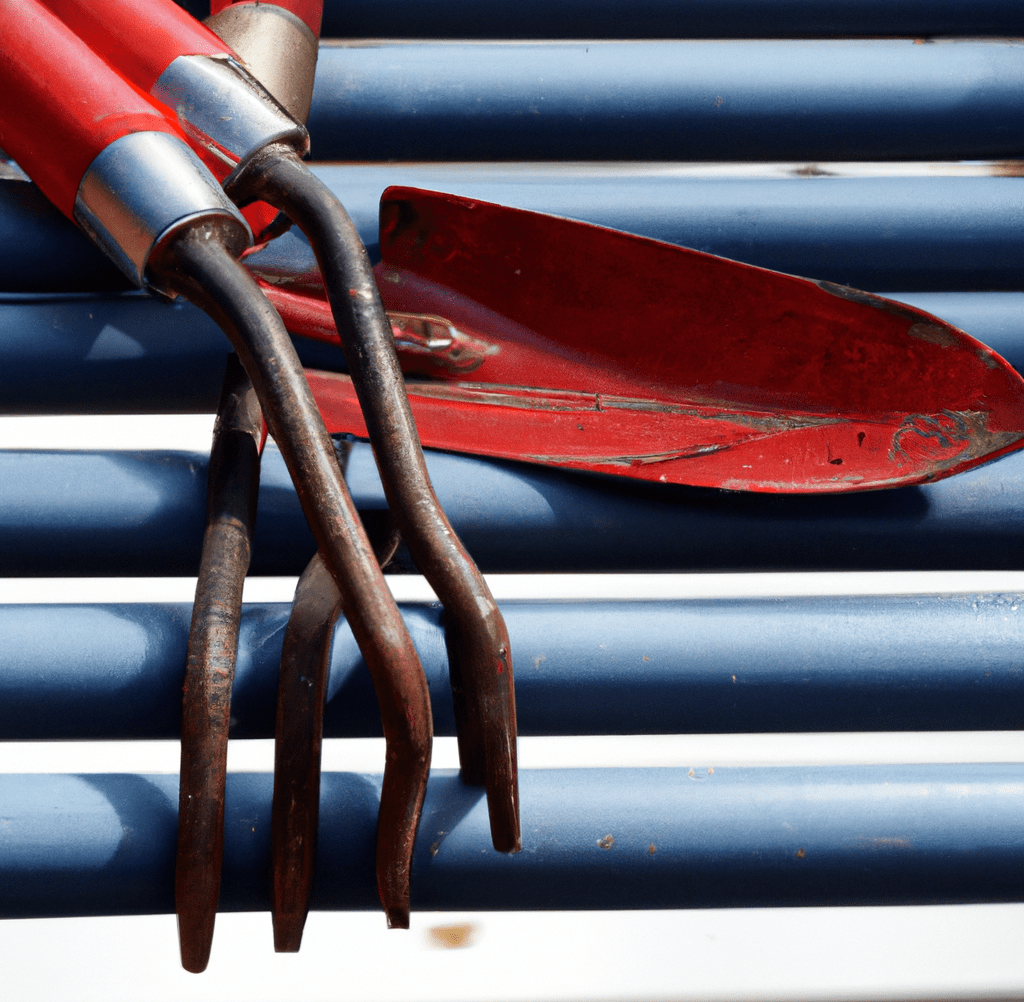
Lubrication and Protection
Garden tool lubrication and metal surface protection are critical for maintaining performance and extending tool life. Different lubricants and protectants are appropriate for different types of tools. To ensure that these substances are effective, they must be applied correctly.
Here’s why learning about how to properly maintain and care for your garden tools also means learning about lubrication:
- Prevents rust and corrosion: Gardeners can help prevent rust and corrosion on their tools by keeping moving parts lubricated, which can cause them to break or become damaged over time
- Improves tool performance: Lubricated moving parts operate more smoothly and efficiently, which can improve overall tool performance and make it easier to use for gardeners.
- Extends tool lifespan: Proper maintenance, such as lubricating moving parts and protecting metal surfaces, can help gardening tools last longer.
Gardeners can help ensure that their gardening tools are in good working order and ready to use by taking the time to lubricate moving parts and protect metal surfaces. Gardening tools, with proper care and maintenance, can last for years and make it easier to keep gardens and landscapes looking their best.
Types of Lubricants and Protectants Suitable for Different Types of Tools
Now that you know about how to properly maintain and care for your garden tools, here are the different lubricants and protectants you can use:
- Mineral oil: is ideal for lubricating moving parts and protecting metal surfaces. They are simple to apply and provide a thin, protective layer that aids in the prevention of rust and corrosion.
- Grease: a thicker, heavier-duty lubricant that is ideal for use on heavy-duty tools like mowers and tillers. It acts as a moisture barrier and helps to prevent rust and corrosion.
- WD-40: WD-40 is a well-known multi-purpose lubricant and protectant that can be used on a wide range of tools. It aids in the displacement of moisture and provides a thin, protective layer that aids in the prevention of rust and corrosion.
- Silicone spray: a water-resistant lubricant and protectant that can be applied to metal surfaces such as gardening tools. It creates a long-lasting protective barrier that aids in the prevention of rust and corrosion.
Gardeners should use the lubricant or protectant that is best suited to their tools and the conditions under which they are used. Gardeners can help keep their tools in good working order and ensure that they last for years by regularly lubricating moving parts and protecting metal surfaces.
Tips for Applying Lubricants and Protectants Properly
As you learn more about how to properly maintain and care for your garden tools, here’s how to apply protectants and lubricants properly:
- Use the proper lubricant: Different types of gardening tools necessitate different lubricants. Metal surfaces, for example, may require oil to prevent rust, whereas moving parts may require light grease. Make sure to use the proper lubricant for each tool type.
- Clean before lubricating: Thoroughly clean the tool before applying any lubricant or protectant. Because dirt and debris can reduce the effectiveness of the lubricant, it is critical to remove these contaminants first.
- Apply evenly: When applying lubricant or protectant to a tool, make sure to spread it evenly across the surface. This will help to ensure that all areas of the tool are protected and lubricated, improving overall performance.
- Reapply on a regular basis: Lubricants and protectants will eventually wear off, so it’s critical to reapply them. This will help to keep the tool functional and long-lasting even after repeated use.
Bottom Line: How to Properly Maintain and Care For Your Garden Tools
Gardening is a rewarding and enjoyable hobby that necessitates the use of the proper tools in order to be successful. As a gardener, you must learn how to properly maintain and care for your garden tools Gardeners can keep their tools in good condition and ready for use by cleaning and disinfecting them on a regular basis, sharpening and adjusting them, storing and transporting them, and lubricating and protecting them.
Also, proper garden tool maintenance and care are critical for extending the life of your tools and making gardening a more efficient and enjoyable experience. Gardeners should be aware of the importance of regularly cleaning, sharpening, storing, and lubricating their tools, as well as continuing to learn and experiment with new techniques to keep their tools in top shape. Whether you’re an experienced gardener or just getting started, taking the time to care for your tools will pay dividends in the long run.
How to Properly Maintain and Care For Your Garden Tools FAQs
Why’s it crucial to look after and maintain garden tools?
To last for several seasons, gardening equipment needs to be properly cared for and maintained. Gardening tools that aren’t kept clean and maintained can rust, which weakens and damages the tool and renders it useless and even dangerous. Regular upkeep can help instruments last longer and necessitate fewer replacements overall, saving money and assisting in the reduction of waste.
How should gardening tools be cleaned and sanitized?
- Use a wire brush to scrub away any grease, caked-on dirt, or corrosion.
- White vinegar and water mixed in equal parts should be applied to the tool for several hours to remove rust.
- Baking soda and water can be combined to produce a paste that can be applied on rust spots and left in place for several hours before being removed with a damp cloth.
- Use a rust remover product designed specifically for rust removal from gardening tools if the rust is extremely difficult to remove.
- To avoid further rust and corrosion, completely dry the tool after the rust has been removed, and store it in a dry, protected area.
How are garden tools sharpened and adjusted?
- Check the tool for wear or damage, and replace or repair any that show signs of being damaged or worn out.
- With the aid of a tool sharpener or honing guide, sharpen the blades at the right angle.
- Make sure to sharpen the blades at the same angle each time while doing so by hand. Maintaining the right edge on the blades is made easier with a constant angle.
- After the blades have been sharpened, clean off any dirt or rust that has developed by using a metal brush.
- To prevent rust and other types of corrosion, store tools away from moisture and heat when not in use.


